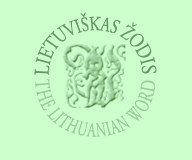-
-
- EDUCATION. The first school in
Lithuania to be mentioned in historical sources is the Cathedral School
of Vil- nius, 1397. Known from the beginning of the 16th century are the
second elementary school in Vilnius, St. John's, and a few in other
cities. There were probably other elementary schools at that period,
since the diocesan synod of Vilnius (1527-28) ordered the establishment
of houses where pupils might live and study. The students were boys,
mostly the sons of gentry and burghers. The first secondary school
evolved from the Cathedral School of Vilnius when its curriculum was
expanded to include rhetoric, dialectic, and music. This school prepared
candidates for theological studies at the Academy of Cracow. To prepare
students for Western European universities another secondary school was
established in Vilnius in 1539. Special attention was given to Latin,
Greek, and to classical culture. In charge of this humanistic school was
Abraomas Kulvietis (q.v.), one of the best-educated men in Lithuania at
that time. When he began to propagate Protestantism, the school was
closed in 1542. St. John's School in Vilnius also became a secondary
school in 1563, when courses in law were introduced.
The Reformation emanating from Western Europe in the 16th century gave
impetus to the establishment of new schools. Catholics and Protestants,
vying with one another, founded schools not only in the cities, but also
on estates. The more notable Protestant secondary schools were
established in Šiluva (1592), Kėdainiai (1625), and Slutsk (1626). The
latter two were supported by the eminent family of Lithuanian nobility
named Radvilas (Radziwill). In the school of Kėdainiai, called" gymnasium
illustre, Greek, Latin, German, mathematics, philosophy, and Sacred
Scripture were taught. With the school were a library of about 30,000
volumes and a press.
- Catholic schools were established mostly
by religious orders. Among these the predominant role was played by the
Jesuits between 1569-1773. Their efforts were concentrated on colleges
devoted to the humanities in the Western European style. The first
college was founded in Vilnius in 1569. This formed the basis for the
Academy of Vilnius, founded in 1579. By the end of the 16th century the
Jesuits already had 5 colleges in Lithuania. In the 17th century the
number rose to 25; during the 18th century it grew to 30. The most
renowned were in Vilnius, Kražiai and Polotsk. In smaller Jesuit
colleges courses lasted 3 years, in larger ones 5. Studies were arranged
according to the curriculum established by the Society ot Jesus, called
the Ratio Stitdiorum. The method was Scholastic and the language
used, Latin, (gee Jesuits).
The Jesuits enjoyed the ims exclusiwum docendi, which forbade any
other religious order from establishing schools in any place where the
Society of Jesus had a school. The Plarists contested this privilege by
establishing in 1718-53 about 10 schools called collegia nobilia
(colleges of nobility). In
- their curricula they introduced new
subjects: geography, civics, natural sciences, business and agricultural
administration, and modern languages (German, French and Russian).
Teaching was in Polish rather than in Latin.
- The entire course of studies required from
6 to 7 years. Vying with the Piarists, the Jesuits began in 1741 to
modernize their colleges also. However, their order was suppressed by
Pope Clement XIV in 1773, and Jesuit schools and property were
confiscated by the state.
- To administer schools taken over from the
Jesuits, and bother schools, a national Educational Commission (q.v.)
was established in 1773, serving Lithuania and Poland. Lithuania was
divided into 4 educational districts. In each a district school of 6
grades (7 years) was established together with several sub-district
schools of 3 grades (6 years). In all, 28 state schools were
established. Other secondary and primary schools remained private, in
the hands of Augustinians, Basilians, and Piarists. The Educational
Commission adopted a curriculum not much different from that of the
Piarists; emphasis was placed on history and geography, law, natural
sciences, and agriculture. The tenor of education was liberal, in
keeping with the ideas of the Enlightenment then prevalent. The language
used in teaching was changed from Latin to Polish. The Educational
Commission decided to introduce compulsory schooling tor children 7-12
years old. This decision, however, was not implemented because the
gentry objected to the education of the serfs. Supervision of all
schools was assigned to the Academy of Vilnius, which was given the new
title of Principal School of Lithuania. When Russia annexed Lithuania in
1795, the name was changed to Principal School of Vilnius. Deleting the
name of Lithuania underscored the abrogation of the nation’s right of
self-determination.
-
- Text from the ENCYCLOPEDIA LITUANICA I-VI.
Boston, 1970-1978
-

